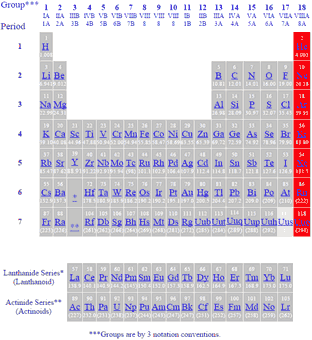
Helium
| Element | Helium |
| Symbol | He |
| Atomic Number | 2 |
| Molar Mass | 4 gmol-1 |
| Electron Configuration | 1s2 |
| Normal State | gas/nonmetal |
| Density @STP | 0.18x10-3 g cm-3 |
| Melting Point | -272oC |
| Boiling Point | -296oC |
| Stable Isotopes | 3He, 4He |
| Atomic Radius | 128 pm |
| Ionic Radius | n/a pm |
| Electronegativity (Pauling) | n/a |
| Ionization Energy (1st) | 2372 kJ mol-1 |
| Ionization Energy (2nd) | 5250 kJ mol-1 |
| Ionization Energy (3rd) | n/a kJ mol-1 |
| Molar Heat Capacity | 20.8 J K-1mol-1 |
| Standard Molar Entropy | 126.2 J K-1mol-1 |
| Enthalpy of Fusion | 0.021 kJ mol-1 |
| Enthalpy of Vapourization | 0.082 kJ mol-1 |
[Back to Periodic table]
- Helium is a colorless odorless monatomic noble gas element
- Helium discovered by Pierre Janssen, Norman Lockyer (1868)
- Helium first isolation by William Ramsay, Per Teodor Cleve, Abraham Langlet (1895)
- Helium Named after Helios, Greek Titan of the Sun
- Helium has a valence of zero and is chemically unreactive under all normal conditions
- Helium is the second lightest and second most abundant element in the universe after hydrogen
- Majority of helium was formed during the Big Bang. Large amounts of new helium are being created by nuclear fusion of hydrogen in stars
- Elements other than hydrogen and helium today account for only 2% of the mass of atomic matter in the universe, Helium making up about 23%
- Helium is the only element to remain liquid down to absolute zero at normal pressures and requires much higher pressures to become solid
- Helium liquid can be cooled to point where it becomes a superfluid showing no measurable viscosity and thermal conductivity greater than that of any other known substance
- Helium has nine known isotopes only helium-3 and helium-4 are stable
- Helium present today is created by the natural radioactive decay of heavy radioactive elements producing alpha particles (helium-4 nuclei)
- Helium is trapped with natural gas in concentrations as great as 7% by volume, from which it is extracted commercially by fractional distillation
- Helium once released into the atmosphere eventually escapes into space
- Helium has many uses that require some of its unique properties, like low boiling point, low density, low solubility, high thermal conductivity, or inertness
- Liquid helium is used in cryogenics, particularly in the cooling of superconducting magnets, with the main commercial application being in MRI scanners
- Helium is used as a protective atmosphere for arc welding and in processes such as growing crystals to make silicon wafers
- Helium is used in balloons and airships as it is safer than hydrogen
- Helium is used as a plasma gas in thermal spray processes
- Helium diffuses through solids three times faster than air, it is used as a tracer gas to detect leaks in high-vacuum equipment
- The age of rocks and minerals that contain uranium and thorium can be estimated by measuring the level of helium with a process known as helium dating
- Helium gas mixtures are used for breathing during deep diving to reduce the effects of narcosis
- Helium is not toxic, but is an asphyxiant


Telephone: +44 (0)1252 405186
Email: tsc@gordonengland.co.uk
Site Links
Introducing
Nature of Thermal Spray Coatings
Surface Engineering in a Nutshell
Surface Engineering Forum
Thermal Spray Gun Repair Service
Plasma Consumable Parts
Thermal Spray Powder Supplies
Applications:
Thermal Spray Coatings on Carbon and Glass Fibre Reinforced Polymers
HVOF Coating of Paper Making Roll
Abradable Coatings
Photomicrographs
Thermal Spray Processes:
Combustion Wire Thermal Spray Process
Combustion Powder Thermal Spray Process
Arc Wire Thermal Spray Process
Plasma Thermal Spray Process
HVOF Thermal Spray Process
HVAF Thermal Spray Process
Detonation Thermal Spray Process
Plasma Flame Theory
Cold Spray Coating Process
Wear and Use of Thermal Spray Coatings
Corrosion and Use of Thermal Spray Coatings
Glossary of Thermal Spray and Surface Engineering Terms
Image Directory for Thermal Spray Coatings
Plasma Gas Flow Information
Plasma Gas Flow Correction Calculator
Contact Form
Links to other interesting sites related to thermal spray and surface engineering
Reciprocal Links
Periodic Table of the Elements
SI Units
Calculators for Conversion between Units of Measurement
Hardness Testing
Surface Engineering Message Board Archive
Surface Engineering Message Board Archive Index
Photography Gallery2
Photography Gallery3
© Copyright Gordon England




